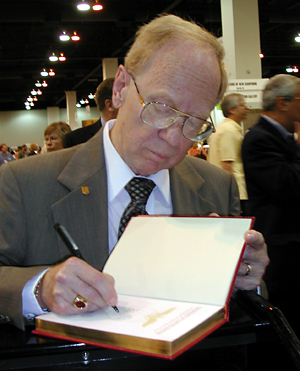By Dr. Sol Taylor
"Making Cents"
Saturday, July 28, 2007
| I |
|
Now, to honor its 60th anniversary, Whitman Publishing reproduced an exact replica of the 1947 edition, with the same pictures and descriptions as the original.
At the March 2007 auction of Michael Aron Rare Coins in Van Nuys, each successful bidder spending $250 or more at the sale received a copy of the special reprinted edition.
Naturally, the Red Book has undergone many changes and additions over the years. Some of the more significant early features included:
1. For most coin issues, only two grades (plus proofs, when there were proof issues) were listed for each coin: Fine and Unc for many earlier issues (prior to 1860), and for some later issues, such as Indian head cents, three grades: Good, Fine and Unc.
2. The mintage figures were listed at the end of the book, not with the coins.
3. For more recent issues such as Washington quarters, only one column grade was listed — Unc. Proofs were listed for the years with proof issues.
4. Very few varieties were listed for each series, such as the 1918/17-S quarter, which was valued at $30 in Fine and $150 in Unc.
5. Coins and tokens of Hawaii, the Philippines, and other regional issues were not included.
6. The 60th anniversary issue has several pages at the end pointing out the major changes (other than prices) of the Red Book over the six decades of issue.
7. No bibliography was listed for each issue, due mainly to a lack of reference books on each coin series in the early 1940s.
8. The copyright date was 1946.
9. There were only 14 numismatists listed as contributors, including partners Abe Kosoff and Abner Kreisberg, Max M. Schwartz, Aubrey Bebee, Stuart Mosher, Louis M. Reagan and Farran Zerbe. No doubt, prices were also obtained from dealers of the time, in addition to men such as Max Mehl, Maurice M. Gould, the Stack brothers, and others.
A key statement for someone who took the time to calculate these numbers found that one of each coin in circulated condition would cost $167,970, and the same coins in Unc (mint) condition would cost $219,609. In 2007, the same coins would sell for $10.9 million and $45 million respectively. With the fine-tuning since grading became formalized in the 1980s, the uncirculated coins could easily top $150 million in Mint State-65 grades or higher.
The early editions of the Red Book were not major sellers, and mint copies today are worth a considerable sum. A very fine 1947 edition was offered for sale by Michael Aron for $850. After just a few years, the coin collecting boom hit high gear in 1960 with the appearance of the "Coin World" hobby newspaper and the excitement of the 1960 small-date cent. Sales of Red Books hit new highs for several years in a row, including the 1964 issue, spurred by the new Kennedy half dollar and the end of 90-percent silver coinage.
Dr. Sol Taylor of Sherman Oaks is president of the Society of Lincoln Cent Collectors and author of The Standard Guide to the Lincoln Cent. Click here for ordering information.
©2007 SCV COMMUNICATIONS GROUP & SOL TAYLOR · ALL RIGHTS RESERVED.

![[Most Recent Quotes from www.kitco.com]](http://www.kitconet.com/images/quotes_special.gif)

